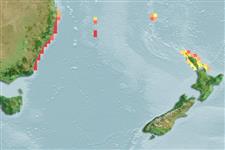Environment: milieu / Zona climática / intervalo de profundidade / distribution range
Ecologia
marinhas; estuarina pelagic-neritic; intervalo de profundidade 0 - 20 m (Ref. 6390). Temperate; 28°S - 37°S
Southwest Pacific: eastern Australia from Moreton Bay, Queensland to Eden, New South Wales, including Lord Howe and Norfolk Islands.
Tamanho / Peso / Idade
Maturidade: Lm ? range ? - ? cm
Max length : 39.8 cm SL macho/indeterminado; (Ref. 10988)
Descrição suscinta
Chaves de identificação | Morfologia | Morfometria
Espinhos dorsais (total) : 0; Raios dorsais (total) : 15 - 17; Espinhos anais: 0; Raios anais : 17 - 20; Vértebras: 56 - 58. Preorbital canal with a posterior branch. Relatively longer jaws, especially at larger sizes. Gill rakers usually 34 or more in the first arch and usually 27 or more on the second arch.
Body shape (shape guide): elongated.
Found in sheltered bays, clear coastal waters and sometimes in estuaries (Ref. 27012). Generally herbivorous. Feed mainly on seagrasses and algal filaments (Ref. 26551, 27013). Eastern sea garfish also consume a high proportion of crustaceans (Ref. 27013). A schooling fish, found generally near the surface at night and close to the sea floor over seagrass beds during the day (Ref. 6390). They are being preyed upon by mulloway (Argyrosomus hololepidotus) and tailor (Pomatomus saltatrix), as well as coastal water birds. No studies have been reported on the spawning of this species (Ref. 6390).
Ciclo de vida ou comportamento de acasalamento
Maturidade | Reprodução | Desova | Ovos | Fecundidade | Larvas
Viviparous.
Collette, B.B., 1974. The garfishes (Hemiramphidae) of Australia and New Zealand. Records of the Australian Museum 29(2):11-105. (Ref. 10988)
Status na Lista Vermelha da UICN (Ref. 130435: Version 2025-1)
Ameaça para os humanos
Harmless
Uso pelos humanos
Pescarias: espécies comerciais; isca: usually
Ferramentas
Relatórios especiais
Baixar XML
Fontes da internet
Estimates based on models
Preferred temperature (Ref.
123201): 18 - 23.4, mean 20.7 °C (based on 55 cells).
Índice de diversidade filogenética (Ref.
82804): PD
50 = 0.5000 [Uniqueness, from 0.5 = low to 2.0 = high].
Bayesian length-weight: a=0.00257 (0.00115 - 0.00574), b=3.09 (2.91 - 3.27), in cm total length, based on LWR estimates for this Genus-body shape (Ref.
93245).
Nível Trófico (Ref.
69278): 2.6 ±0.25 se; based on food items.
Resiliência (Ref.
120179): Elevada, tempo mínimo de duplicação da população menor que 15 meses (Preliminary K or Fecundity.).
Fishing Vulnerability (Ref.
59153): Low vulnerability (23 of 100).
🛈
